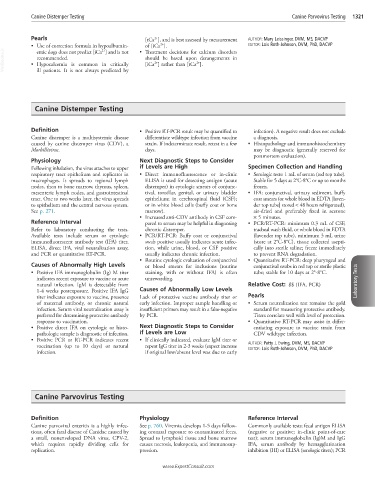Page 2605 - Cote clinical veterinary advisor dogs and cats 4th
P. 2605
Canine Distemper Testing Canine Parvovirus Testing 1321
Pearls [tCa ], and is best assessed by measurement AUTHOR: Mary Leissinger, DVM, MS, DACVP
2+
2+
of [iCa ].
• Use of correction formula in hypoalbumin- • Treatment decisions for calcium disorders EDITOR: Lois Roth-Johnson, DVM, PhD, DACVP
VetBooks.ir • Hypocalcemia is common in critically should be based upon derangements in
2+
emic dogs does not predict [iCa ] and is not
recommended.
2+
2+
[iCa ] rather than [tCa ].
ill patients. It is not always predicted by
Canine Distemper Testing
Definition • Positive RT-PCR result may be quantified to infection). A negative result does not exclude
Canine distemper is a multisystemic disease differentiate wildtype infection from vaccine a diagnosis.
caused by canine distemper virus (CDV), a strain. If indeterminate result, retest in a few • Histopathology and immunohistochemistry
Morbillivirus. days. may be diagnostic (generally reserved for
postmortem evaluation).
Physiology Next Diagnostic Steps to Consider
Following inhalation, the virus attaches to upper if Levels are High Specimen Collection and Handling
respiratory tract epithelium and replicates in • Direct immunofluorescence or in-clinic • Serologic tests: 1 mL of serum (red top tube).
macrophages. It spreads to regional lymph ELISA is used for detecting antigen (acute Stable for 5 days at 2°C-8°C or up to months
nodes, then to bone marrow, thymus, spleen, distemper) in cytologic smears of conjunc- frozen.
mesenteric lymph nodes, and gastrointestinal tival, tonsillar, genital, or urinary bladder • IFA: conjunctival, urinary sediment, buffy
tract. One to two weeks later, the virus spreads epithelium; in cerebrospinal fluid (CSF); coat smears (or whole blood in EDTA [laven-
to epithelium and the central nervous system. or in white blood cells (buffy coat or bone der top tube] stored < 48 hours refrigerated),
See p. 271. marrow). air-dried and preferably fixed in acetone
• Increased anti-CDV antibody in CSF com- × 5 minutes.
Reference Interval pared to serum may be helpful in diagnosing • PCR/RT-PCR: minimum 0.3 mL of CSF,
Refer to laboratory conducting the tests. chronic distemper. tracheal wash fluid, or whole blood in EDTA
Available tests include serum or cytologic • PCR/RT-PCR: Buffy coat or conjunctival (lavender top tube), minimum 3 mL urine
immunofluorescent antibody test (IFA) titer, swab positive usually indicates acute infec- (store at 2°C-8°C), tissue collected asepti-
ELISA, direct IFA, viral neutralization assay, tion, while urine, blood, or CSF positive cally into sterile saline; freeze immediately
and PCR or quantitative RT-PCR. usually indicates chronic infection. to prevent RNA degradation.
• Routine cytologic evaluation of conjunctival • Quantitative RT-PCR: deep pharyngeal and
Causes of Abnormally High Levels or blood smears for inclusions (routine conjunctival swabs in red top or sterile plastic
• Positive IFA immunoglobulin (Ig) M titer staining, with or without IFA) is often tube; stable for 10 days at 2°-8°C.
indicates recent exposure to vaccine or acute unrewarding. Laboratory Tests
natural infection. IgM is detectable from Relative Cost: $$ (IFA, PCR)
1-4 weeks postexposure. Positive IFA IgG Causes of Abnormally Low Levels
titer indicates exposure to vaccine, presence Lack of protective vaccine antibody titer or Pearls
of maternal antibody, or chronic natural early infection. Improper sample handling or • Serum neutralization test remains the gold
infection. Serum viral neutralization assay is insufficient primers may result in a false-negative standard for measuring protective antibody.
preferred for determining protective antibody by PCR. Titers correlate well with level of protection.
response to vaccination. • Quantitative RT-PCR may assist in differ-
• Positive direct IFA on cytologic or histo- Next Diagnostic Steps to Consider entiating exposure to vaccine strain from
pathologic sample is diagnostic of infection. if Levels are Low CDV wildtype infection.
• Positive PCR or RT-PCR indicates recent • If clinically indicated, evaluate IgM titer or
vaccination (up to 10 days) or natural repeat IgG titer in 2-3 weeks (expect increase AUTHOR: Patty J. Ewing, DVM, MS, DACVP
EDITOR: Lois Roth-Johnson, DVM, PhD, DACVP
infection. if original low/absent level was due to early
Canine Parvovirus Testing
Definition Physiology Reference Interval
Canine parvoviral enteritis is a highly infec- See p. 760. Viremia develops 1-5 days follow- Commonly available tests: fecal antigen ELISA
tious, often fatal disease of Canidae caused by ing oronasal exposure to contaminated feces. (negative or positive; in-clinic point-of-care
a small, nonenveloped DNA virus, CPV-2, Spread to lymphoid tissue and bone marrow test); serum immunoglobulin (Ig)M and IgG
which requires rapidly dividing cells for causes necrosis, leukopenia, and immunosup- IFA, serum antibody by hemagglutination
replication. pression. inhibition (HI) or ELISA (serologic titers); PCR
www.ExpertConsult.com

